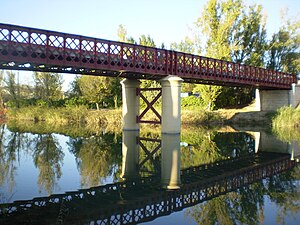Puente de Fuentidueña de Tajo
Coordinates: 40 ° 6 ′ 50 ″ N , 3 ° 9 ′ 18 ″ W.
| Puente de Fuentidueña de Tajo | ||
|---|---|---|
| use | Road bridge | |
| Convicted | M-831 | |
| Crossing of | Tagus | |
| place | at Fuentidueña de Tajo | |
| construction | Lattice girder bridge | |
| overall length | 65.2 m | |
| width | 6 m | |
| Number of openings | two | |
| Longest span | 31.61 m | |
| start of building | 1868 | |
| completion | 1871 | |
| location | ||
|
|
||
The Puente de Fuentidueña de Tajo leads the M-831 road to the town of Fuentidueña de Tajo in the southeast of the Autonomous Community of Madrid over the Tajo .
It was founded between 1868 and 1871 by the French company Eng. Imbert et Cie. It is the second oldest wrought - iron bridge in Spain after the Puente de Isabel II (1852) in Seville , apart from the small bridge in Parque de El Capricho in Madrid , which was built in 1830.
description
The 65.2 m long bridge is 6 m wide between the girders, divided into a 4 m wide carriageway and two 1 m wide walkways. It has two 2.50 m high wrought iron lattice girders constructed as continuous girders , which are supported by a pair of pillars standing in the middle of the river. The deck is supported by a combination of diagonal and cross members. The pillars consist of cast iron pipes filled with concrete with a chalk-like coating. They are stiffened by a wrought iron St. Andrew's cross .
It is closed to trucks.
history
The Puente de Fuentidueña de Tajo is located on a route from Madrid to Valencia , which was described in the 16th century and which became a post road in the 17th century. In the 19th century the place was on the first order road from Madrid to Castellón de la Plana .
The first bridge over the Tagus at this point was a simple suspension bridge built in 1842 by the Sociedad de Puentes Colgantes . Jules Seguin, one of Marc Seguin's brothers , tried to market the type of bridge produced by the family in Spain. The suspension bridge was destroyed again in 1866 when General Prim wanted to cut off his pursuers.
In the competition for an iron replacement building, which was announced a little later, the company Eng. Imbert et Cie. against ten competitors.
The bridge is similar to the Moulins (Allier) railway bridge completed in 1858 , a type common in France at the time.
Many of the early iron bridges in Spain, regardless of their year of construction, are often referred to as the Puente Eiffel , including the Puente Eiffel en Fuentidueña de Tajo , as the name Eiffel became a generic term after the sensational construction of the Ponte Maria Pia in Porto .
The bridge was renovated in 2001.
Web links
Individual evidence
- ^ Iron bridge in Parque El Capricho File: Jardin El Capricho-Iron bridge.jpg
- ↑ El Puente de Fuentidueña de Tajo on Pasión por Madrid.blogspot.com
- ↑ Juan José Arenas de Pablo: La ingeniería de puentes en la España del siglo XIX . In: José Manuel Iglesias Gil (ed.): Cursos sobre el património histórico: actas de los IX Cursos Monográficos sobre el Patrimonio Histórico, Reinosa, julio-agosto 1998 . tape 3 . Ed. Universidad de Cantabria, Santander 1999, ISBN 84-8102-233-0 , pp. 163 ( limited preview in Google Book search).
- ↑ Puente de Fuentidueña on Fuentiduena de Tajo.org

